I want to detect button tap on a UITableViewCell where the parent UITableView consists of multiple sections.
I was able to do it in the case of single section, but I got into trouble determining the correct section where there were more than one.
I am trying to determine the correct section corresponding to the UITableViewCell where the user has tapped on the button.
Here is the updated code after the problem is being solved:
@property (strong, nonatomic) NSMutableArray* quantityArray;
@property (strong, nonatomic) NSMutableArray* rows;
@synthesize quantityArray,rows;
- (void)viewDidLoad {
[super viewDidLoad];
quantityArray = [[NSMutableArray alloc] init];
[self PluMinusFunction];
}
- (UITableViewCell *)tableView:(UITableView *)tableView cellForRowAtIndexPath:(NSIndexPath *)indexPath {
//
// Some code here.
//
if (addBtnClicked || minusBtnClicked) {
cell.lblCount.text = [[quantityArray objectAtIndex:indexPath.section-1]objectAtIndex:indexPath.row];
addBtnClicked = NO;
minusBtnClicked = NO;
} else {
cell.lblCount.text = [[quantityArray objectAtIndex:indexPath.section-1]objectAtIndex:indexPath.row];
}
cell.btnMinus.tag = indexPath.row;
cell.btnPlus.tag = indexPath.row;
cell.lblCount.tag = indexPath.row;
[cell.btnPlus addTarget:self action:@selector(addItem:) forControlEvents:UIControlEventTouchUpInside];
if ([ cell.lblCount.text integerValue]!=0) {
[cell.btnMinus addTarget:self action:@selector(deleteItem:) forControlEvents:UIControlEventTouchUpInside];
}
return cell;
}
}
#pragma mark - Plus Minus Button
- (void)PluMinusFunction {
for (int j=0; j <[itemArr count]; j++) {
rows = [[NSMutableArray alloc] init];
for (int i=0; i <[ [[itemArr objectAtIndex:j] objectForKey:@"itemList"]count]; i++) {
[rows insertObject:@"0" atIndex:i];
}
[quantityArray insertObject:rows atIndex:j];
}
[self sum];
}
#pragma mark - UIButton selector
- (void)addItem:(UIButton*)button {
CGPoint touchPoint = [button convertPoint:CGPointZero toView:self.tableView];
NSIndexPath *clickedButtonIndexPath = [self.tableView indexPathForRowAtPoint:touchPoint];
NSInteger row = clickedButtonIndexPath.row;
NSInteger section = clickedButtonIndexPath.section;
NSInteger LabelText =[[[quantityArray objectAtIndex:section-1]objectAtIndex:row]integerValue] + 1;
NSMutableArray *subArray = [quantityArray objectAtIndex:section-1];
[subArray replaceObjectAtIndex:row withObject: [NSString stringWithFormat:@"%ld",(long)LabelText]];
[quantityArray replaceObjectAtIndex:section-1 withObject: subArray];
addBtnClicked = YES;
NSIndexPath* rowToReload = [NSIndexPath indexPathForRow:row inSection:section];
NSArray* rowsToReload = [NSArray arrayWithObjects:rowToReload, nil];
[self.tableView reloadRowsAtIndexPaths:rowsToReload withRowAnimation:UITableViewRowAnimationNone];
}
- (void)deleteItem:(UIButton*)button {
CGPoint touchPoint = [button convertPoint:CGPointZero toView:self.tableView];
NSIndexPath *clickedButtonIndexPath = [self.tableView indexPathForRowAtPoint:touchPoint];
NSInteger row = clickedButtonIndexPath.row;
NSInteger section = clickedButtonIndexPath.section;
NSInteger LabelValue =[[[quantityArray objectAtIndex:section-1]objectAtIndex:row]integerValue];
if (LabelValue >= 1) {
NSInteger LabelText =[[[quantityArray objectAtIndex:section-1]objectAtIndex:row]integerValue] - 1;
NSMutableArray *subArray = [quantityArray objectAtIndex:section-1];
[subArray replaceObjectAtIndex:row withObject: [NSString stringWithFormat:@"%ld",(long)LabelText]];
[quantityArray replaceObjectAtIndex:section-1 withObject: subArray];
addBtnClicked = YES;
NSIndexPath* rowToReload = [NSIndexPath indexPathForRow:row inSection:section];
NSArray* rowsToReload = [NSArray arrayWithObjects:rowToReload, nil];
[self.tableView reloadRowsAtIndexPaths:rowsToReload withRowAnimation:UITableViewRowAnimationNone];
}
}
I want to achieve the layout as shown below:
This link gave the solution to my problem too:
